LDAP Authentication¶
ownCloud ships an LDAP backend, which allows full use of ownCloud for users logging in with LDAP credentials including:
- LDAP group support
- File sharing with users and groups
- Access via WebDAV and of course ownCloud Desktop Client
- Versioning, external Storages and all other ownCloud goodies
To connect to an LDAP server the configuration needs to be set up properly. Once the LDAP backend is activated (Apps Sidebar→Apps, choose LDAP user and group backend, click on Enable) the configuration can be found on Settings→Admin. Read on for a detailed description of the configuration fields.
Configuration¶
The LDAP backend configuration follows a wizard-like approach, split into four tabs. A correctly completed first tab (“Server”) is mandatory to access the other tabs. The settings in the other tabs are detected automatically, but should be reviewed by the admin. An indicator will show whether the configuration is incomplete, incorrect or OK.
The settings are changed automatically, as soon as a input element loses the focus, i.e. the cursor is taken away by clicking somewhere else or pressing the Tab key.
The other tabs can be navigated by clicking the tabs or by using the Continue and Back buttons. They are located on the lower right, next to the status indicator.
Server¶
The Server tab contains the basic information on the LDAP server. They make sure that ownCloud will be able to connect to LDAP and be able to read data from there. The admin at least needs to provide a hostname. If anonymous access is not possible he will need to provide an account DN and a password, too. ownCloud attempts to auto-detect the port and the base DN.
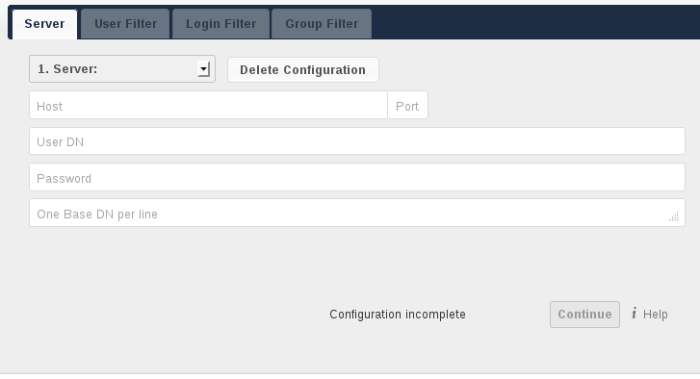
- Server configuration:
- ownCloud can be configured to connect to multiple LDAP servers. Using this control you can pick a configuration you want to edit or add a new one. The button Delete Configuration deletes the current configuration.
- Host:
The host name of the LDAP server. It can also be a ldaps:// URI, for instance.
It is also possible to pass a port number, which speeds up port detection. It is especially useful, if a custom port is used. ownCloud will move the value to the port field subsequently.
Examples:
- directory.my-company.com
- ldaps://directory.my-company.com
- directory.my-company.com:9876
- Port:
The port on which to connect to the LDAP server. The field is disabled in the beginning of a new configuration. The port will be detected automatically, if the LDAP server is running on a standard port. After ownCloud attempted to determine the port, the field will be enabled for user input. A successfully found port will be inserted by ownCloud, of course.
Example:
- 389
- User DN:
The name as DN of a user who is able to do searches in the LDAP directory. Leave it empty for anonymous access. It is recommended to have a special system user for ownCloud.
Example:
- uid=owncloudsystemuser,cn=sysusers,dc=my-company,dc=com
- Password:
- The password for the user given above. Empty for anonymous access.
- Base DN:
The base DN of LDAP, from where all users and groups can be reached. Separated Base DNs for users and groups can be set in the Advanced tab. Nevertheless, this field is mandatory. ownCloud attempts to determine the Base DN according to the provided User DN or the provided Host.
Example:
- dc=my-company,dc=com
User Filter¶
The settings in the User Filter tab determine which LDAP users will appear and are allowed to log in into ownCloud. It is also possible to enter a raw LDAP filter.
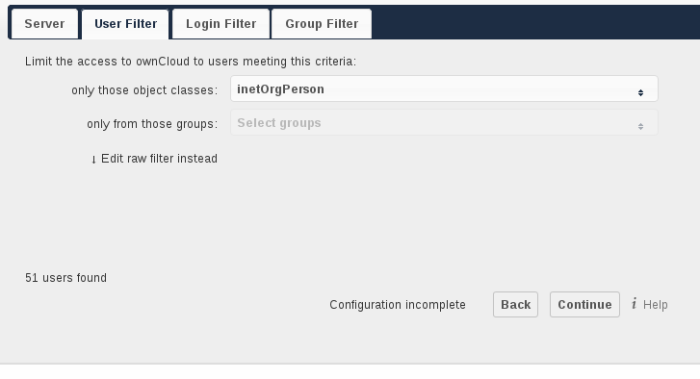
- only those object classes:
- ownCloud will determine the object classes that are typically available for (ideally only) user objects in your LDAP. ownCloud will automatically select the object class that returns the highest amount of users. You can select multiple object classes.
- only from those groups:
If your LDAP server supports the member-of-overlay in LDAP filters, you can define that only users from one or more certain groups are allowed to appear and log in into ownCloud. By default, no value will be selected. You can select multiple groups.
If your LDAP server does not support the member-of-overlay in LDAP filters, the input field is disabled. Please contact your LDAP administrator.
- Edit raw filter instead:
Clicking on this text will toggle the filter mode. Instead of the assisted approach, you can enter the raw LDAP filter directly in the appearing field.
Example:
- objectClass=inetOrgPerson
- x users found:
- This is an indicator that tells you approximately how many users will be allowed to access ownCloud. The number will update after any change you do.
Login Filter¶
The settings in the Login Filter tab determine which user detail will be compared to the login value entered by the user. It is possible to allow multiple user details. It is also possible to enter a raw LDAP filter.
The user limitation as set up in the previous tab is in effect, unless you manually configure the filter in raw mode.
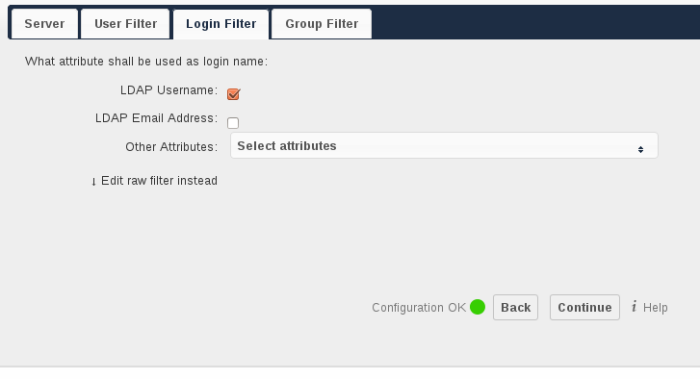
- LDAP Username:
- If this value is checked, the login value will be compared to the username in the LDAP directory. The corresponding attribute, usually uid or samaccountname will be detected automatically by ownCloud.
- LDAP Email Address:
- If this value is checked, the login value will be compared to an email address in the LDAP directory. The email address will be looked for in the mailPrimaryAddress and mail attributes.
- Other Attributes:
- This multiselect box allows you to select other attributes for the comparison. The list is generated automatically based on the attributes that a user object contains in your LDAP server.
- Edit raw filter instead:
Clicking on this text will toggle the filter mode. Instead of the assisted approach, you can enter the raw LDAP filter directly in the appearing field.
The %uid placeholder will be replaced with the login name entered by the user upon login. When you enter the filter manually.
Examples:
- only username: uid=%uid
- username or email address: (|(uid=%uid)(mail=$uid))
Group Filter¶
The settings in the Group Filter tab determine which groups will be available in ownCloud. It does not have any restrictions on logins, this has been dealt with in the prior tabs. It is also possible to enter a raw LDAP filter.
By default, no groups will be available in ownCloud. You actively need to enable groups.
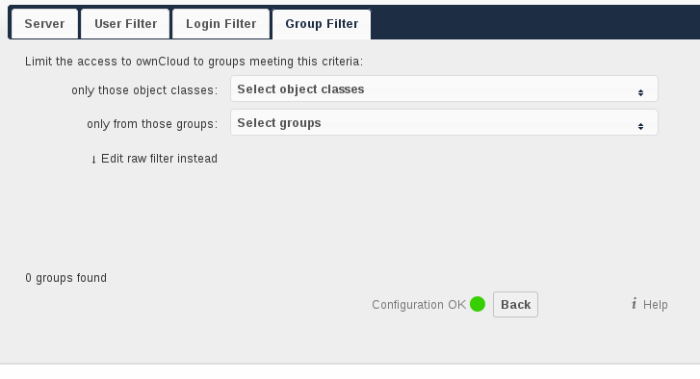
- only those object classes:
- ownCloud will determine the object classes that are typically available for (ideally only) group objects in your LDAP. ownCloud will only list object classes that return at least one group object. You can select multiple object classes. A typical object class is “group”, or “posixGroup”.
- only from those groups:
- This setting lets you pick certain groups that shall be available in ownCloud. This field follows a whitelist approach. ownCloud will generate a list of available groups found in your LDAP server. You can select multiple groups.
- Edit raw filter instead:
Clicking on this text will toggle the filter mode. Instead of the assisted approach, you can enter the raw LDAP filter directly in the appearing field.
Example:
- objectClass=group
- objectClass=posixGroup
- y groups found:
- This is an indicator that tells you approximately how many groups will be available in ownCloud. The number will update after any change you do.
Advanced Settings¶
In the LDAP Advanced Settings section you can define options, that are less common to set. They are not needed for a working connection. It can also have a positive effect on the performance to specify distinguished bases for user and group searches.
The Advanced Settings are structured into three parts:
- Connection Settings
- Directory Settings
- Special Attributes
Connection Settings¶
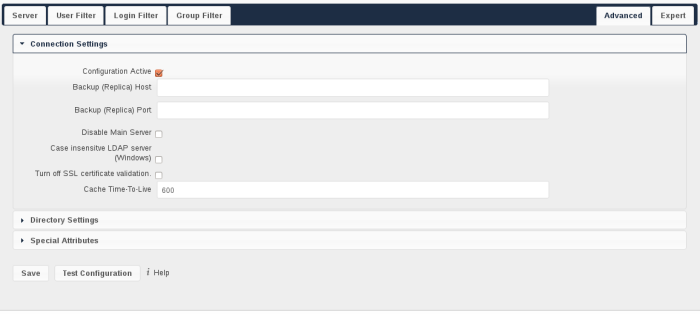
LDAP Advanced Settings, section Connection Settings
- Configuration Active:
Enables or Disables the current configuration. Disabled configuration will not connect to the LDAP server.
By default, it is turned off. It will be automatically turned on, when using the wizard and the configuration is OK and a test connection successful.
- Backup (Replica) Host:
A backup server can be defined here. ownCloud tries to connect to the backup server automatically, when the main host (as specified in basic settings) cannot be reached. It is important that the backup server is a replica of the main server, because the object UUIDs must match.
Example:
- directory2.my-company.com
- Backup (Replica) Port:
The port on which to connect to the backup LDAP server. If no port is given, but a host, then the main port (as specified above) will be used.
Example:
- 389
- Disable Main Server:
- You can manually override the main server and make ownCloud only connect to the backup server. This may be handy for planned downtimes.
- Case insensitive LDAP server (Windows):
- Whether the LDAP server is running on a Windows host. Usually, it is not necessary to check it, however.
- Turn off SSL certificate validation:
- Turns off check of valid SSL certificates. Use it – if needed – for testing, only!
- Cache Time-To-Live:
A cache is introduced to avoid unnecessary LDAP traffic, for example lookups check whether the users exist on every page request or WebDAV interaction. It is also supposed to speed up the Admin → User page or list of users to share with, once it is populated. Saving the configuration empties the cache (changes are not necessary). The time is given in seconds.
Note that almost every PHP request would require to build up a new connection to the LDAP server. If you require most up-to-dateness it is recommended not to totally switch off the cache, but define a minimum life time of 15s.
Examples:
- ten minutes: 600
- one hour: 3600
Directory Settings¶
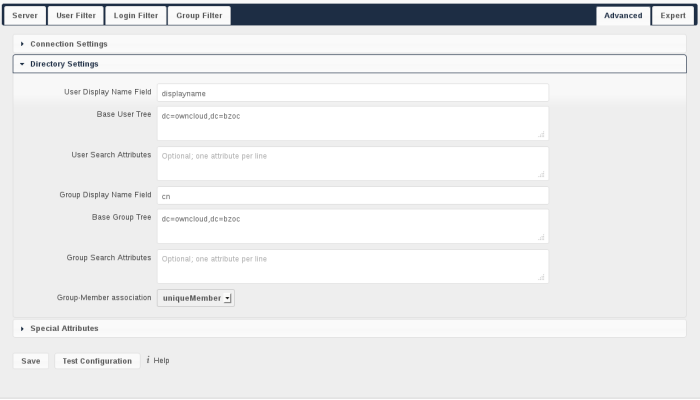
LDAP Advanced Settings, section Directory Settings
- User Display Name Field:
The attribute that should be used as display name in ownCloud.
- Example: displayName
- Base User Tree:
The base DN of LDAP, from where all users can be reached. It needs to be given completely despite to the Base DN from the Basic settings. You can specify multiple base trees, one in each line.
Example:
cn=programmers,dc=my-company,dc=comcn=designers,dc=my-company,dc=com
- User Search Attributes:
These attributes are used when a search for users is done. This happens, for instance, in the share dialogue. By default the user display name attribute as specified above is being used. Multiple attributes can be given, one in each line.
Beware that if an attribute is not available on a user object, the user will neither be listed (e.g. in the share dialogue) nor be able to login. This also affects the display name attribute as specified above. If you override the default, the display name attribute will not be taken into account, unless you specify it as well.
Example:
displayNamemail
- Group Display Name Field:
The attribute that should be used as ownCloud group name. ownCloud allows a limited set of characters (a-zA-Z0-9.-_@), every other character will be replaced in ownCloud. Once a group name is assigned, it will not be changed, i.e. changing this value will only have effect to new LDAP groups.
- Example: cn
- Base Group Tree:
The base DN of LDAP, from where all groups can be reached. It needs to be given completely despite to the Base DN from the Basic settings. You can specify multiple base trees, one in each line.
Example:
cn=barcelona,dc=my-company,dc=comcn=madrid,dc=my-company,dc=com
- Group Search Attributes:
These attributes are used when a search for groups is done. This happens, for instance, in the share dialogue. By default the group display name attribute as specified above is being used. Multiple attributes can be given, one in each line.
If you override the default, the group display name attribute will not be taken into account, unless you specify it as well.
Example:
cndescription
- Group Member association:
The attribute that is used to indicate group memberships, i.e. the attribute used by LDAP groups to refer to their users.
ownCloud detects the value automatically. You should only change it if you have a very valid reason and know what you are doing.
- Example: uniquemember
Special Attributes¶
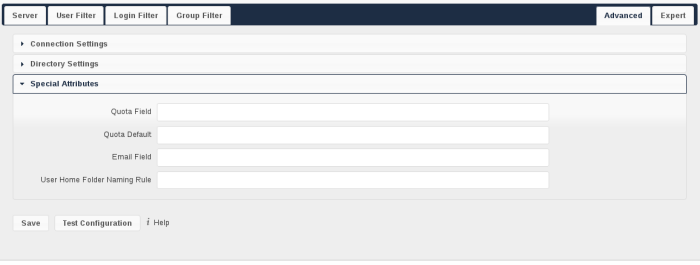
LDAP Advanced Settings, section Special Attributes
- Quota Field:
ownCloud can read an LDAP attribute and set the user quota according to its value. Specify the attribute here, otherwise keep it empty. The attribute shall return human readable values, e.g. “2 GB”.
- Example: ownCloudQuota
- Quota Default:
Override ownCloud default quota for LDAP users who do not have a quota set in the attribute given above.
- Example: 15 GB
- Email Field:
ownCloud can read an LDAP attribute and set the user email there from. Specify the attribute here, otherwise keep it empty.
Although the wizard offers you to check login by email, the correct email attribute is not detected and you need to specify it manually.
- Example: mail
- User Home Folder Naming Rule:
By default, the ownCloud creates the user directory, where all files and meta data are kept, according to the ownCloud user name. You may want to override this setting and name it after an attribute value. The attribute given can also return an absolute path, e.g. /mnt/storage43/alice. Leave it empty for default behavior.
- Example: cn
Expert Settings¶
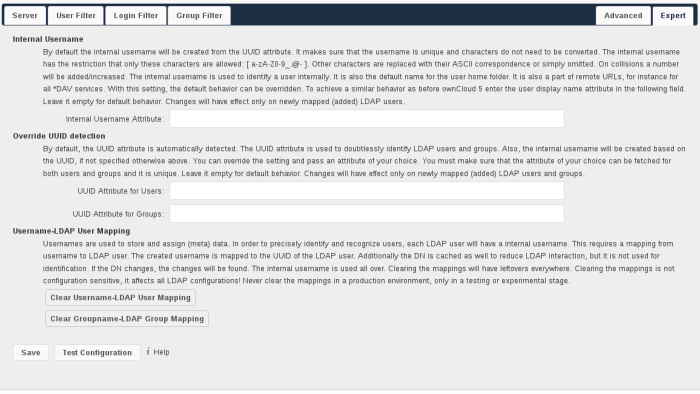
In the Expert Settings fundamental behavior can be adjusted to your needs. The configuration should be done before starting production use or when testing the installation.
- Internal Username:
The internal username is the identifier in ownCloud for LDAP users. By default it will be created from the UUID attribute. By using the UUID attribute it is made sure that the username is unique and characters do not need to be converted. The internal username has the restriction that only these characters are allowed: [a-zA-Z0-9_.@-]. Other characters are replaced with their ASCII correspondence or are simply omitted.
The LDAP backend ensures that there are no duplicate internal usernames in ownCloud, i.e. that it is checking all other activated user backends (including local ownCloud users). On collisions a random number (between 1000 and 9999) will be attached to the retrieved value. For example, if “alice” exists, the next username may be “alice_1337”.
The internal username is also the default name for the user home folder in ownCloud. It is also a part of remote URLs, for instance for all *DAV services. With this setting the default behaviour can be overridden.
Leave it empty for default behaviour. Changes will have effect only on newly mapped (added) LDAP users.
- Example: uid
- Override UUID detection
By default, ownCloud auto-detects the UUID attribute. The UUID attribute is used to doubtlessly identify LDAP users and groups. Also, the internal username will be created based on the UUID, if not specified otherwise above.
You can override the setting and pass an attribute of your choice. You must make sure that the attribute of your choice can be fetched for both users and groups and it is unique. Leave it empty for default behaviour. Changes will have effect only on newly mapped (added) LDAP users and groups. It also will have effect when a user’s or group’s DN changes and an old UUID was cached: it will result in a new user. Because of this, the setting should be applied before putting ownCloud in production use and cleaning the bindings (see below).
- Example: cn
- Username-LDAP User Mapping
ownCloud uses the usernames as key to store and assign data. In order to precisely identify and recognize users, each LDAP user will have a internal username in ownCloud. This requires a mapping from ownCloud username to LDAP user. The created username is mapped to the UUID of the LDAP user. Additionally the DN is cached as well to reduce LDAP interaction, but it is not used for identification. If the DN changes, the change will be detected by ownCloud by checking the UUID value.
The same is valid for groups.
The internal ownCloud name is used all over in ownCloud. Clearing the Mappings will have leftovers everywhere. Never clear the mappings in a production environment. Only clear mappings in a testing or experimental stage.
Clearing the Mappings is not configuration sensitive, it affects all LDAP configurations!
Testing the configuration¶
The Test Configuration button on the bottom of the LDAP settings section will always check the values as currently given in the input fields. You do not need to save before testing. By clicking on the button, ownCloud will try to bind to the ownCloud server with the settings currently given in the input fields. The response will look like this:
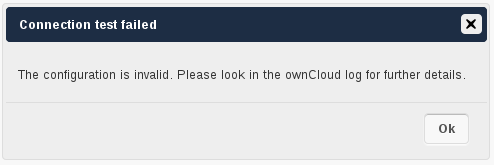
Failure
In case the configuration fails, you can see details in ownCloud’s log, which is in the data directory and called owncloud.log or on the bottom the Settings → Admin page. Unfortunately it requires a reload – sorry for the inconvenience.

Success
In this case, Save the settings. You can check if the users and groups are fetched correctly on the Settings → Users page.
ownCloud Avatar integration¶
ownCloud 6 incorporates a user profile picture feature, called Avatar. If a user has a photo stored in the jpegPhoto or, since 6.0.2, thumbnailPhoto attribute, it will be used as Avatar. The user then is not able to change his avatar in the personal settings. It must be done within LDAP. jpegPhoto is preferred over thumbnailPhoto.
Profile picture fetched from LDAP, Personal Settings
If the jpegPhoto or thumbnailPhoto attribute is not set or empty, the default ownCloud behaviour is active, i.e. the user will be able to set and change his profile picture in the personal settings. If the user sets a profile picture within ownCloud it will _not_ be stored in LDAP.
The jpegPhoto or thumbnailPhoto attribute will be fetched once a day to make sure the current photo from LDAP is used in ownCloud. If a picture is added later, a possibly set profile picture will be overridden with the LDAP one. If a photo stored in the jpegPhoto and/or thumbnailPhoto attribute is deleted later, the last profile picture in ownCloud will still be used.
The photo taken from LDAP will be adjusted to the requirements of the ownCloud avatar automatically, i.e. it will be transformed into a square. If the photo needs to be cut, it will be done equally from both affected sides. The original photo stored in LDAP will stay the same, of course.
Troubleshooting, Tips and Tricks¶
SSL Certificate Verification (LDAPS, TLS)¶
A common mistake with SSL certificates is that they may not be known to PHP. If you have trouble with certificate validation make sure that
- you have the certificate of the server installed on the ownCloud server
- the certificate is announced in the system’s LDAP configuration file (usually /etc/ldap/ldap.conf on Linux, C:\openldap\sysconf\ldap.conf or C:\ldap.conf on Windows) using a TLS_CACERT /path/to/cert line.
- Using LDAPS, also make sure that the port is correctly configured (by default 686)
Microsoft Active Directory¶
Compared to earlier ownCloud versions, no further tweaks need to be done to make ownCloud work with Active Directory. ownCloud will automatically find the correct configuration in the wizard-like set up process.
Duplicating Server Configurations¶
In case you have a working configuration and want to create a similar one or “snapshot” configurations before modifying them you can do the following:
- Go to the Server tab
- On Server Configuration choose Add Server Configuration
- Answer the question Take over settings from recent server configuration? with yes.
- (optional) Switch to Advanced tab and uncheck Configuration Active in the Connection Settings, so the new configuration is not used on Save
- Click on Save
Now you can modify the configuration and enable it if you wish.
ownCloud LDAP Internals¶
Some parts of how the LDAP backend works are described here. May it be helpful.
Groups¶
At the moment, only secondary groups are read. That means that only the groups are retrieved, which are returned by the attribute auto-detected (or manually chosen) in Group-Member association. Primary groups are not taken into account.
User and Group Mapping¶
In ownCloud the user or group name is used to have all relevant information in the database assigned. To work reliably a permanent internal user name and group name is created and mapped to the LDAP DN and UUID. If the DN changes in LDAP it will be detected, there will be no conflicts.
Those mappings are done in the database table ldap_user_mapping and ldap_group_mapping. The user name is also used for the user’s folder (except something else is specified in User Home Folder Naming Rule), which contains files and meta data.
As of ownCloud 5 internal user name and a visible display name are separated. This is not the case for group names, yet, i.e. group cannot be altered.
That means that your LDAP configuration should be good and ready before putting it into production. The mapping tables are filled early, but as long as you are testing, you can empty the tables any time. Do not do this in production. If you want to rename a group, be very careful. Do not rename the user’s internal name.
Caching¶
For performance reasons a cache has been introduced to ownCloud. The cache stores all users and groups, group memberships or internal userExists-requests. Since ownCloud is written in PHP and each and every page request (also done by Ajax) loads ownCloud and would execute one or more LDAP queries again, you do want to have some of those queries cached and save those requests and traffic. It is highly recommended to have the cache filled for a small amount of time, which comes also very handy when using the sync client, as it is yet another request for PHP.
Handling with Backup Server¶
When ownCloud is not able to contact the main server, it will be treated as offline and no connection attempts will be done for the time specified in Cache Time-To-Live. If a backup server is configured, it will be connected instead. For planned downtime, check Disable Main Server for the time being to avoid unnecessary connection attempts every now and then.